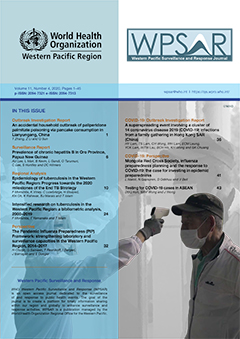A superspreading event involving a cluster of 14 coronavirus disease 2019 (COVID-19) infections from a family gathering in Hong Kong SAR (China)
DOI:
https://doi.org/10.5365/wpsar.2020.11.1.012Abstract
Objective: An outbreak of coronavirus disease 2019 (COVID-19) caused by severe acute respiratory syndrome coronavirus 2 (SARS-CoV-2) was first reported in Wuhan, China, in December 2019, with subsequent spread around the world. Hong Kong Special Administrative Region SAR (China) recorded its first confirmed cases on 23 January 2020. In this report, we describe a family cluster of 12 confirmed cases, with two additional confirmed cases from secondary transmission.
Methods: We reported the epidemiological, clinical and laboratory findings of the family cluster, as well as the public health measures instituted.
Results: All 12 confirmed COVID-19 cases were among the 19 attendees of a three-hour Chinese New Year family dinner consisting of hotpot and barbecue dishes. Environmental sampling of the gathering venue was negative. Two additional confirmed cases, who were co-workers of two confirmed cases, were later identified, indicating secondary transmission. Contact tracing, quarantine and environmental disinfection were instituted to contain further spread.
Discussion: Our findings were highly suggestive of a superspreading event during the family gathering. The source was likely one of the cases during the pre-symptomatic phase. The event attested to the high infectivity of SARS-CoV-2 through human-to-human transmission from social activities and argued for the necessity of social distancing in curtailing the disease spread.
References
Gorbalenya AE, Baker SC, Baric RS, et al. Severe acute respiratory syndrome-related coronavirus: the species and its viruses—a statement of the Coronavirus Study Group. bioRxiv. 2020; (published online Feb 11. DOI: 2020.02.07.937862 (preprint).)
Chan JF, Yuan S, Kok KH, To KK, Chu H, Yang J, et al. A familial cluster of pneumonia associated with the 2019 novel coronavirus indicating person-to-person transmission: a study of a family cluster. Lancet. 2020 Feb 15;395(10223):514-523. doi: 10.1016/S0140-6736(20)30154-9. Epub 2020 Jan 24.
Tuite AR, Fisman DN. Reporting, Epidemic Growth, and Reproduction Numbers for the 2019 Novel Coronavirus (2019-nCoV) Epidemic. Annals of Internal Medicine. 2020 Feb 5. doi: 10.7326/M20-0358.
Wu JT, Leung K, Leung GM. Nowcasting and forecasting the potential domestic and international spread of the 2019-nCoV outbreak originating in Wuhan, China: a modelling study. Lancet. 2020 Jan 31. pii: S0140-6736(20)30260-9. doi: 10.1016/S0140-6736(20)30260-9.
World Health Organization. Q&A on infection prevention and control for health care workers caring for patients with suspected or confirmed 2019-nCoV. 16 February 2020. Available from: https://www.who.int/news-room/q-a-detail/q-a-on-infection-prevention-and-control-for-health-care-workers-caring-for-patients-with-suspected-or-confirmed-2019-ncov
Pao J. Hotpot diners ‘caught Wuhan virus via droplets, not aerosols’. Asia Times. 2020 February 10. Available from: https://asiatimes.com/2020/02/hotpot-diners-caught-wuhan-virus-via-droplets-not-aerosols
Rothe C, Schunk M, Sothmann P. Transmission of 2019-nCoV Infection from an Asymptomatic Contact in Germany. The New England Journal of Medicine. 2020 Jan 30. doi: 10.1056/NEJMc2001468.
Backer JA, Klinkenberg D, Wallinga J. Incubation period of 2019 novel coronavirus (2019-nCoV) infections among travellers from Wuhan, China, 20–28 January 2020. Euro Surveillance. 2020 Feb;25(5). doi: 10.2807/1560-7917.ES.2020.25.5.2000062.
Ahmed F, Zviedrite N, Uzicanin A. Effectiveness of workplace social distancing measures in reducing influenza transmission: a systematic review. BMC Public Health. 2018 Apr 18;18(1):518. doi: 10.1186/s12889-018-5446-1.

